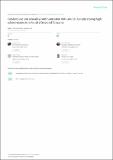Condom use and sexuality communication with adults: a study among high school students in South africa and Tanzania
View/
Publication Date
9/23/2013Type
Article, Journalviews
downloads
Metadata
Show full item recordCitation
Francis, Namisi & Aarø, Leif & Kaaya, Sylvia & Onya, Hans & Wubs, Annegreet & Mathews, Catherine. (2013). Condom use and sexuality communication with adults: A study among high school students in South Africa and Tanzania. BMC public health. 13. 874. 10.1186/1471-2458-13-874.
Abstract/
Background: Fostering adolescents’communication on sexuality issues with their parents and other significantadults is often assumed to be an important component of intervention programmes aimed at promoting healthyadolescent sexual practices. However, there are few studies describing the relationship between suchcommunication and sexual practices, particularly in sub-Saharan Africa. This study examined the relationshipsbetween adolescents’communication with significant adults and their condom use in three sites in this region.Methods: Data stem from a multi-site randomized controlled trial of a school-based HIV prevention interventionimplemented in Cape Town and Mankweng, South Africa and Dar es Salaam, Tanzania. Only data from comparisonschools were used. The design is therefore a prospective panel study with three waves of data collections. Datawere collected in 2004 from 6,251 participants in 40 schools. Associations between adolescents’communicationwith adults about sexuality issues and their use of condoms were analysed cross-sectionally using analysis ofvariance, as well as prospectively using multiple ordinal logistic regression analysis.Results: Cross-sectional analyses showed that consistent condom users had significantly higher mean scores oncommunication (across topics and communication partners) than both occasional users and never-users, who hadthe lowest scores. After controlling for condom use at the first data collection occasion in each model as well as forpossible confounders, communication scores significantly predicted consistent condom use prospectively in allthree ordinal logistic regression models (Model R2= .23 to .31).Conclusion: The findings are consistent with the assertion that communication on sexuality issues betweenadolescents and significant adults results in safer sexual practices, as reflected by condom use, among in-schooladolescents. The associations between communication variables and condom use might have been stronger if wehad measured additional aspects of communication such as whether or not it was initiated by the adolescentsthemselves, the quality of advice provided by adults, and if it took place in a context of positive adult-adolescentinteraction. Studies with experimental designs are needed in order to provide stronger evidence of causality.
Further Details
© 2013 Namisi et al.; licensee BioMed Central Ltd. This is an Open Access article distributed under the terms of the Creative Commons Attribution License (http://creativecommons.org/licenses/by/2.0), which permits unrestricted use, distribution, and reproduction in any medium, provided the original work is properly cited.
Publisher
BMC Public HealthISSN
1471-2458Collections
- General - GEN [367]

